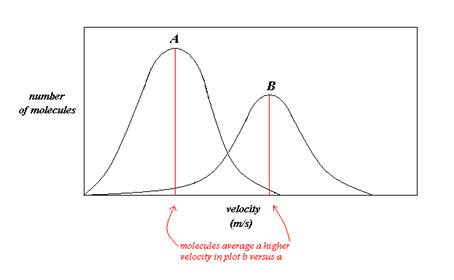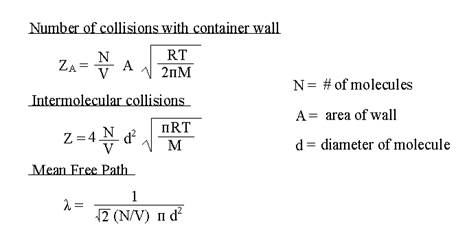Kinetic Molecular Theory - Answer Keys
Back to the other Gases Workbooks and other General Chemistry Workbooks
Go To -> Worksheet - Answer Key - Solutions Manual
- What are the postulates of the kinetic molecular theory?
1. Particles are assumes to have a V = 0
2. Particles are in constant motion
3. Particles do not interact (no attraction)
4. (KE)avg is directly proportional to temperature
- From this information under what conditions would real gases behave similarly to ideal gases?
High temperature and low pressure are the conditions that allow a real gas to most closely approximate ideal gas behavior.
- What is the equation for Average Kinetic Energy?
(KE)avg = 3/2 RT
- What does kinetic energy describe?
The energy of motion.
- How does temperature effect kinetic energy?
The higher the temperature the higher the kinetic energy.
- What is the equation for the root mean square velocity?
μrms = (3RT/M)1/2
- How does mass affect the velocity?
The greater the mass – the slower moving the particle.
- How does temperature affect the velocity?
An increase in temperature results in an increase in velocity.
- Consider:

- If the plot represents the velocity distribution of 1.0 L of H2 (g) versus 1.0 L of Ar (g) at STP, which plot corresponds to each gas?
Plot A represents Ar (g)
Plot B represents H2 (g)
- If the plots correspond to the velocity distribution of 1.0 L of O2 (g) at 273K and 1273K, which plot corresponds to each temperature?
Plot A represents movement at 273K
Plot B represents movement at 1273 K.
- Under which temperature condition would the O2 (g) behave most ideally?
The higher temperature – 1273 K.
- What is diffusion?
Diffusion is the movement of a substance from higher concentration to lower concentration.
- What is effusion?
Effusion is the passage of a gas through a tiny hole into an evacuated chamber.
- What is Graham’s Law?
Compares the rate of effusion of 2 gases.
Rate of effusion gas1 = (M2)1/2
Rate of effusion gas2 (M1)1/2
- It took 5.3 minutes for 1.0 L of helium to effuse through a porous barrier. How long will it take for 1.0L of chlorine gas to effuse under identical conditions?
22.2 minutes
- Consider the following equations

How would the following affect number of collisions and length of mean free path?
- Increase in mass?
Fewer collisions.
No change to length of mean free path.
- Increase in diameter of particle?
More collisions.
Smaller mean free path.
- Increase concentration of gas?
More collisions.
Decreased mean free path.
- What is the Van Der Waal’s Equation?
[Pobserved + a (n/V)2] (V –nb) = nRT
- What is it correcting for?
Pressure is corrected because particles do interact with each other.
Volume corrected because the actual volume is smaller than ideal volume.
- What does the variable “a” have to do with?
I always remember this variable by thinking “a” is for attraction.
The greater the attraction between particles the greater the value of “a”.
- What does the variable “b” have to do with?
I always remember this variable by thinking “b” is for big.
The larger the particles the greater the value of “b”.
- Would He(g) or H2O(g) have a greater value of “a”?
H2O
- Would He(g) or Xe(g) have a smaller value of “b”?
He.
